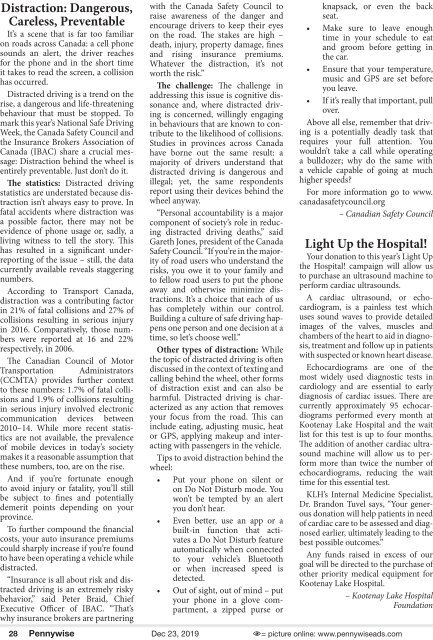Dec 23, Pennywise – Trail, Beaver Valley, Rossland
Complete coverage of Trail, Rossland, Fruitvale, Montrose.
Complete coverage of Trail, Rossland, Fruitvale, Montrose.
You also want an ePaper? Increase the reach of your titles
YUMPU automatically turns print PDFs into web optimized ePapers that Google loves.
Distraction: Dangerous,<br />
Careless, Preventable<br />
It’s a scene that is far too familiar<br />
on roads across Canada: a cell phone<br />
sounds an alert, the driver reaches<br />
for the phone and in the short time<br />
it takes to read the screen, a collision<br />
has occurred.<br />
Distracted driving is a trend on the<br />
rise, a dangerous and life-threatening<br />
behaviour that must be stopped. To<br />
mark this year’s National Safe Driving<br />
Week, the Canada Safety Council and<br />
the Insurance Brokers Association of<br />
Canada (IBAC) share a crucial message:<br />
Distraction behind the wheel is<br />
entirely preventable. Just don’t do it.<br />
The statistics: Distracted driving<br />
tatistics are understated because disraction<br />
isn’t always easy to prove. In<br />
atal accidents where distraction was<br />
possible factor, there may not be<br />
vidence of phone usage or, sadly, a<br />
iving witness to tell the story. This<br />
as resulted in a significant undereporting<br />
of the issue <strong>–</strong> still, the data<br />
urrently available reveals staggering<br />
umbers.<br />
According to Transport Canada,<br />
istraction was a contributing factor<br />
n 21% of fatal collisions and 27% of<br />
ollisions resulting in serious injury<br />
n 2016. Comparatively, those numers<br />
were reported at 16 and 22%<br />
espectively, in 2006.<br />
The Canadian Council of Motor<br />
ransportation Administrators<br />
CCMTA) provides further context<br />
o these numbers: 1.7% of fatal colliions<br />
and 1.9% of collisions resulting<br />
n serious injury involved electronic<br />
ommunication devices between<br />
010<strong>–</strong>14. While more recent statisics<br />
are not available, the prevalence<br />
f mobile devices in today’s society<br />
akes it a reasonable assumption that<br />
hese numbers, too, are on the rise.<br />
And if you’re fortunate enough<br />
o avoid injury or fatality, you’ll still<br />
e subject to fines and potentially<br />
emerit points depending on your<br />
rovince.<br />
To further compound the financial<br />
osts, your auto insurance premiums<br />
ould sharply increase if you’re found<br />
o have been operating a vehicle while<br />
istracted.<br />
“Insurance is all about risk and disracted<br />
driving is an extremely risky<br />
ehavior,” said Peter Braid, Chief<br />
xecutive Officer of IBAC. “That’s<br />
hy insurance brokers are partnering<br />
with the Canada Safety Council to<br />
raise awareness of the danger and<br />
encourage drivers to keep their eyes<br />
on the road. The stakes are high <strong>–</strong><br />
death, injury, property damage, fines<br />
and rising insurance premiums.<br />
Whatever the distraction, it’s not<br />
worth the risk.”<br />
The challenge: The challenge in<br />
addressing this issue is cognitive dissonance<br />
and, where distracted driving<br />
is concerned, willingly engaging<br />
in behaviours that are known to contribute<br />
to the likelihood of collisions.<br />
Studies in provinces across Canada<br />
have borne out the same result: a<br />
majority of drivers understand that<br />
distracted driving is dangerous and<br />
illegal; yet, the same respondents<br />
report using their devices behind the<br />
wheel anyway.<br />
“Personal accountability is a major<br />
component of society’s role in reducing<br />
distracted driving deaths,” said<br />
Gareth Jones, president of the Canada<br />
Safety Council. “If you’re in the majority<br />
of road users who understand the<br />
risks, you owe it to your family and<br />
to fellow road users to put the phone<br />
away and otherwise minimize distractions.<br />
It’s a choice that each of us<br />
has completely within our control.<br />
Building a culture of safe driving happens<br />
one person and one decision at a<br />
time, so let’s choose well.”<br />
Other types of distraction: While<br />
the topic of distracted driving is often<br />
discussed in the context of texting and<br />
calling behind the wheel, other forms<br />
of distraction exist and can also be<br />
harmful. Distracted driving is characterized<br />
as any action that removes<br />
your focus from the road. This can<br />
include eating, adjusting music, heat<br />
or GPS, applying makeup and interacting<br />
with passengers in the vehicle.<br />
Tips to avoid distraction behind the<br />
wheel:<br />
• Put your phone on silent or<br />
on Do Not Disturb mode. You<br />
won’t be tempted by an alert<br />
you don’t hear.<br />
• Even better, use an app or a<br />
built-in function that activates<br />
a Do Not Disturb feature<br />
automatically when connected<br />
to your vehicle’s Bluetooth<br />
or when increased speed is<br />
detected.<br />
• Out of sight, out of mind <strong>–</strong> put<br />
your phone in a glove compartment,<br />
a zipped purse or<br />
knapsack, or even the back<br />
seat.<br />
• Make sure to leave enough<br />
time in your schedule to eat<br />
and groom before getting in<br />
the car.<br />
• Ensure that your temperature,<br />
music and GPS are set before<br />
you leave.<br />
• If it’s really that important, pull<br />
over.<br />
Above all else, remember that driving<br />
is a potentially deadly task that<br />
requires your full attention. You<br />
wouldn’t take a call while operating<br />
a bulldozer; why do the same with<br />
a vehicle capable of going at much<br />
higher speeds?<br />
For more information go to www.<br />
canadasafetycouncil.org<br />
<strong>–</strong> Canadian Safety Council<br />
Light Up the Hospital!<br />
Your donation to this year’s Light Up<br />
the Hospital! campaign will allow us<br />
to purchase an ultrasound machine to<br />
perform cardiac ultrasounds.<br />
A cardiac ultrasound, or echocardiogram,<br />
is a painless test which<br />
uses sound waves to provide detailed<br />
images of the valves, muscles and<br />
chambers of the heart to aid in diagnosis,<br />
treatment and follow up in patients<br />
with suspected or known heart disease.<br />
Echocardiograms are one of the<br />
most widely used diagnostic tests in<br />
cardiology and are essential to early<br />
diagnosis of cardiac issues. There are<br />
currently approximately 95 echocardiograms<br />
performed every month at<br />
Kootenay Lake Hospital and the wait<br />
list for this test is up to four months.<br />
The addition of another cardiac ultrasound<br />
machine will allow us to perform<br />
more than twice the number of<br />
echocardiograms, reducing the wait<br />
time for this essential test.<br />
KLH’s Internal Medicine Specialist,<br />
Dr. Brandon Tuvel says, “Your generous<br />
donation will help patients in need<br />
of cardiac care to be assessed and diagnosed<br />
earlier, ultimately leading to the<br />
best possible outcomes.”<br />
Any funds raised in excess of our<br />
goal will be directed to the purchase of<br />
other priority medical equipment for<br />
Kootenay Lake Hospital.<br />
<strong>–</strong> Kootenay Lake Hospital<br />
Foundation<br />
28 <strong>Pennywise</strong> <strong>Dec</strong> <strong>23</strong>, 2019 = picture online: www.pennywiseads.com


















